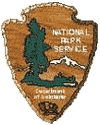
Saber-toothed Salmon
by Ted Fremd
"We live in a zoologically impoverished world, from which all the hugest, and fiercest, and strangest forms have but recently disappeared…"
– Alfred Russel Wallace, 1850's
It's the time of year in the John Day Valley again when we look at the river levels going up and consider how much flooding we might be in for. Those of us who daily drive through Picture Gorge are startled when spring snowmelt takes the water level up over the road in some years, and think of these events as major floods. If we happen to be observant, though, we notice (with a bit of alarm) that far off to the sides in many parts of the valley there are some very large river gravels. These are often dozens of feet above the present river, and are testaments of a much more dramatic river than any in the recorded history of the John Day country (which isn't very long, anyway).
In fact, the water levels in the forks of the John Day River are quite small compared to what they used to be not that long ago. The "big floods" we now see on the river are probably well below normal streamflow back when the Strawberry Mountains area was home to melting glaciers. When outwash from the melting ice surged down the valley, the river was competent enough to transport very large boulders. Even the littlest creeks were much larger and moved a lot of material.
Back then, the animals watching all of this were much larger, too. In some of these gravels, laid down thousands of years ago, we have dug out seven-foot tusks of Columbian mammoths. If it wasn't for the fossils, one might think that many of the creatures that used to live in the northwest were about as believable as Paul Bunyan's big blue ox. The fact is, there really were beavers the size of a black bear, giant ground sloths, lions the length of cars, giant short-faced cave bears, huge "dire" wolves, and many other hefty animals here.
Actually, the big creatures that are still left around us today (elk, bears, mountain lions, etc.) are but a vestige of what was recently here. 75% of all the large animal species in North America went extinct about the same time the last glaciers disappeared from the area. We Just missed seeing them. These beasts were here a geologic minute ago (although 10,000 years sounds like a very long time to most people, paleontologists consider this akin to the blink of an eye).
So, a short time ago, we know on the land there were giant mammals living near the rivers. Soaring over the water alongside relatively puny bald eagles were giant gliding birds like Teratornis, the so-called "Nevada Vulture". Some of these birds had a wingspan of over 15 feet and would stand on the ground at a man's eye height.
But getting back to the river, what was lurking in that powerful current? Is there any reason to think that trout fishing might have been a Lot More Interesting then, even hazardous?
Well, we know the John Day used to be an amazing fishery for many different kinds of salmon. This fishery has deteriorated to its present sad state only in the last hundred or so years. Well before that, there were over 20 different species of salmon living in this region. In fact, the John Day probably was the nearest unglaciated drainage basin during the recent Ice Age, and may have served as something of a refugium for many species of migrating freshwater fish.
One of these, a kind of a Chinook salmon, is known from fossil sites near the Deschutes and also south of here, and so was probably in the John Day River. It must have been inspiring. The rare fossils are from an eight-foot long, deep-bodied anadromous fish named Smilodonichthys, the "saber-toothed salmon", that had fangs approaching 2 inches. It is named after one of its contemporary beasts, the saber-toothed "tiger" named Smilodon that sported 6" fangs (see picture).
Unlike the saber-toothed tiger, the teeth on these huge "saber-toothed salmon" were probably used only for fighting, not eating. The skull bones of this fish indicate it actually fed by filtering the water with 100's of rakers, and feasted on tiny plankton and other minute organisms. So, you probably wouldn't have had any luck getting one of these to strike your fishing lure. No doubt, there would have been plenty of things hungrily watching you try, though…
The FOSSIL RECORD is a monthly column written by the paleontologist at John Day Fossil Beds for local newspapers in Eastern Oregon...
fossil-record/9.htm